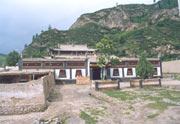|
Youning Temple and the drawing and brick carving art
 In early period, the Tu nationality believed in Shamanism, then it transferred to believe in Gelu group, Tibetan Buddhism. In the 32nd year of Wanli emperor in the Ming dynasty (1064), a temple of the Gelu group named as Guolong Temple was built in Huzhu, where the Tu nationality inhabited. During the Yongzheng years in the Qing dynasty, it was renamed as Youning Temple. After that, many temples were built in the regions of the Tu nationality, but Youning Temple was still the largest one in the regions where the Tu nationality inhabited, and it was called as the mother of all temples in north part of the Huang River (in Qinghai province). In history, the temples in Huzhu, Datong and Ledu regions were mostly the branches of Youning Temple. These temples were the places where the people of the Tu and Tibetan nationalities that believed in Tibetan Buddhism went on religious activities. At the end of the Ming dynasty and the beginning of the Qing dynasty, the monks in Youning Temple ever reached 6,000 people, and Youning Temple was the largest temple in Qinghai province at that time. In early period, the Tu nationality believed in Shamanism, then it transferred to believe in Gelu group, Tibetan Buddhism. In the 32nd year of Wanli emperor in the Ming dynasty (1064), a temple of the Gelu group named as Guolong Temple was built in Huzhu, where the Tu nationality inhabited. During the Yongzheng years in the Qing dynasty, it was renamed as Youning Temple. After that, many temples were built in the regions of the Tu nationality, but Youning Temple was still the largest one in the regions where the Tu nationality inhabited, and it was called as the mother of all temples in north part of the Huang River (in Qinghai province). In history, the temples in Huzhu, Datong and Ledu regions were mostly the branches of Youning Temple. These temples were the places where the people of the Tu and Tibetan nationalities that believed in Tibetan Buddhism went on religious activities. At the end of the Ming dynasty and the beginning of the Qing dynasty, the monks in Youning Temple ever reached 6,000 people, and Youning Temple was the largest temple in Qinghai province at that time.
The drawing and carving art of the Tu nationality is closely related with the belief of Tibetan Buddhism. The Tu nationality has some monk and common craftsmen that are specially engaged in drawing hanging scroll Buddha and the murals of Buddhist Scripture stories, and the molding of Buddha. Concurrently, they are also proficient in drawing or carving the decorative patterns that symbolize luck and happiness on the ridgepole and beam, door and window of temples and dwelling houses. People call the people that are engaged in this profession as "Regong lasuo", and they call this kind of characteristic art form as "Regong art".
Additionally, as the local Hui, Han and other nationalities, the Tu nationality is also proficient in brick carving art, which is the art form of using mud or bricks as raw materials and going on the creation of carving art or architectural decoration. Generally, the brick carving is divided into two types: lift type and carving type. The former uses clay mud to make dragons, phoenix, lion and all kinds of flowers, birds, worms and fishes by hand or mould, then put it into kiln and bake it; the latter carves all kinds of relief sculpture on black bricks. The brick carving can often be found on all kinds of buildings in temples and dwelling houses, and are mostly concentrated on arched doors, yard walls, screen walls and flowerbeds, etc. Most of the brick carving patterns of the Tu nationality ingeniously connect the mountain-and-water scene with auspicious words, with interesting new approach. The picture is drawn carefully and precisely, the mould is vivid and the carving technology is exquisite, all of these fully show the architectural and carving art level of the people of the Tu nationality.
Entertaining guests with three cups of wine <<
The widely applied embroidery technology >>
|